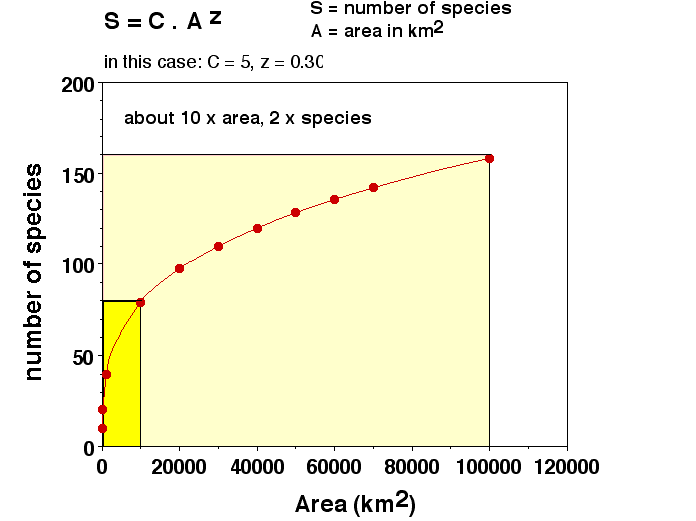Biodiversity - Invasive Species - Mass Extinctions
Biodiversity - Invasive Species - Mass Extinctions
We will address the following topics in a set of lectures on
biodiversity:
Before we can discuss how many species occur on Earth, we have to
know what a species is.
What is a Species?
How many species are there?
Why do we think we have not described all species?
We are sure that we do not know how many species are present on Earth: everytime that someone starts to study tropical insects, they find hundreds and hundreds of non-described species. With mammals and birds, however, it rarely occurs that a not yet described species is discovered; butterflies are also rather well known, as clear by the fact that rarely new species are discovered. Last year, for instance, a 'new' mammal (Laonastes aenigmamus) was described (only known from markets in Laos, sold as food, never seen alife in the wild, and it made all the major newspapers and TV stations (later it was found that this animal's relatives had been described as fossils, but were thought to have been extinct for 11 million years).
Where do we know least/most? Our knowledge is very uneven: we
know most about large plants and animals that are visible from the
surface of land. Huge underground fungi are discovered commonly, even
in places such as western Europe and North America, where the most
intensive studies have been conducted.
Note that particularly isects in the tropics, which are almost cretainly a huge part of all species on Earth, are not well known at all.
How to guess? we'll justy talk about a few of the many
methods
How to guess?

In the first way of guessing overall species richness on Earth, we use various ratios of known and unknown numbers of species, in order to derive an estimate for all species on Earth. As an example, we can use the number of butterflies (a well-studied group) in a well-studied region (UK), and see what the ratio is of butterflies to 'all insects'. Then we look at the number of species of butterflies in a less well-studied region (e.g., Amazon rain forest), and assume that the same ration of butterflies/insects applies there as in the UK.
This leads to an estimate of 6 million insects; ~8 million species
Specific group of
organisms in a specific place in tropics: extrapolate
This is a different application of the ratio-methods. One studies a specific group of organisms in a small region in the tropics (where least is known), and extrapolates from there to all organisms in the tropics, and then to all organisms over the whole world.
As an example:
This leads to an estimate of 30 million species of insects; 40 million species on Earth.
Species area curves
In this model one uses assumptions (different for each group of organsms) about how many species can live in a specific surface area. Clearly, groups of breeding populations need a minimum space to survive in. One needs specific minimum number of individuals in order to get a viable breeding group, and that number of individuals needs a specific area in order to get enough nutrients (in plants), or food (in animals). These equations have been derived empirically, largely by studying the number of species present on island of a specific size (e.g., Caribbean).
Number of species depends on area: S = CAZ
S: number of species; A: area in square kilometers; C: constant; Z: constant (0.15 - 0.35).
When C equals about 5 (usually valid from something the size of a small mammals, lizard, bird); and z equals about 0.30, an area ten times as large as another area can hold twice the number of species (see figure below). We can then study the number of species in a small region, and from there extrapolate to a much larger region.

Note though, that on a continental scale we would not have a higher global species richness (in fact, the reverse) if all continents were combined into one huge continent (the Australia effect). If there are several different continents, each can have its own species (or group of species) filling the same niche. For example, kangaroos are the large herbivores on Australia in rather open plains, with bison as their counterpart in North America, various antelopes in Africa. If all continents were combined into one, these species would directly compete with each other, and presumably several would go extinct.
'Species richness' vs. 'Diversity'
'Diversity' (vernacular) = number of species
'Diversity' (professional) = various mathematical combinations of species richness (number of species) and distribution of specimens over species
Distribution of specimens over species: assume 100
specimens, 10 species
10 species, each 10 specimens (left figure below)
10 species, 9 with 1 specimen, 1 with 91 (right figure below)
In the left type of distribution, the chance of collecting 2 different species when collecting two different specimens at random is much larger than the the right-habd type of distribution.


Why so many species? Why not more? Is the Earth 'full' of
species?
How do species find niches so that competition is at a minimum, and they coexist together with many other species? We need to look into the methods of generation of new species in order to try to understand this. We know that during Earth history overall species richness increased; the world; the world went from being populated by bacteria and archaea 4 billion year ago to a world populated by many species of animals, plants, fungi, protists , and Archaea and Bacteria.
Allopatric speciation:
'different countries'. Most species are thought to originate by
'allopatric speciation'.
Note: the 'allopatric' can not be seen as its most simplistic, another region. For a small insect, the stem of a tree may be a different region than the interior of a leaf.

How to minimize competition and maximize species
richness:
Cropping principle: presence of herbivores creates more niches for plants -> increases diversity of plants (predators - prey); although this appears to be counter-intuitive! In ecosystems where the main diversity is determined by species interactions, the number of species tends to be high. Such a high-diversity system mainly defined by interactions between species can exist only if the physical/chemical factors of life are not extremely difficult for organisms to handle (e.g., few metabolic recations can run wehn there is no water at all, below freezing or totally dry), and also are not too variable. Where the environments is extremely variable (e.g., between high and low tide, which is covered with salt water part of time, dry the other part) organisms are mainy defined by their adaptations to these harsh environmental circumstances.
This is in contrast with locations where the main diversity is determined by interaction with physical (or chemical) factors in their environment (see below).
Over geological time (about 534 million years since the origin of multicellular animals) diversity has increased, with some researchers (e.g., Mike Benton, UK) arguing that we see a logarithmic increase in number of species (although interrupted by mass extinctions). If that is true, than we can argue that the diversity of species on earth is not a fixed number, and we do not know the 'true' carrying capacity of the number of species on earth: the number may be determined by how many species are there..
Figure: estimate of number of all genera (taxonomic category bove the species) on earth over geological time (Benton, M. J., 2001, Biodiversity on land and in the sea, Geological Journal 36, p. 211-230)

Where on Earth does highest diversity occur?
What do these regions have in common? At first, it might look as if these region have high primary productivity (coral reefs, tropical rainforests), but this is not true for the deep ocean. These regions share the character that they have little variability on all different types of time scales: not much seasonal change, not much change on longer time scales (ice ages)
Life at higher latitudes, at shallower depths in the oceans,
'accident-prone'

New species evolve all the time: allopatric speciation,
cropping principle
Does 'more species' mean a 'more stable ecosystem'?
Compare: 'polar bears and snow hares' with 'foxes and ten species of rodents' (complexity-stability theory) . The idea was that in low-diversity ecosystems extinctions of one species will have much more serious consequences than in high-diversity ecosystems. If the snow hare dies, the polar bear also goes, but if one species of rodent goes, the foxes can switch, was the simplified argument. This theory is no longer widely accepted, largely because the idea that different species can easily replace each other (in role in the ecosystem) has been documented to be not valid in several cases. This argument (more diverse ecosysetm are more stable) involved circular reasoning: if high diversity ecosystems are high-diversity because they are less variable (more stable), than that stability was there to start with, and is not supplied by the ecosystem.
Highly diverse tropical ecosystems are much more vulnerable to physical disturbance than the lower diversity high-latitude ecosystems, because their inhabitants can not deal with (are not adapted to deal with) environmental variability.
Genetically modified organisms
or